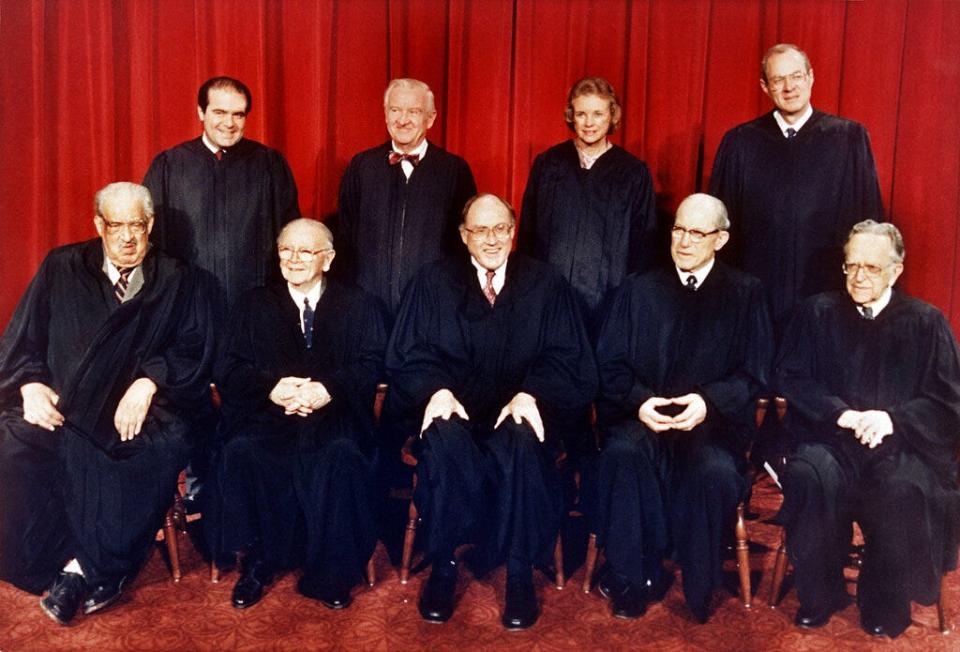Sandra Day O'Connor's abortion rights rulings still reverberate in Arizona, nation
It is possible that Arizona voters next year will weigh in on whether to enshrine abortion rights into the state’s constitution.
No matter how that issue turns out, the late Supreme Court Justice Sandra Day O’Connor played a role in pushing it to the fore.
O’Connor, who died Friday in Phoenix after years of battling dementia, authored the 1992 legal ruling that preserved for another 30 years the federal abortion rights first recognized in the case known as Roe v. Wade.
But she placed those rights on a different legal footing, and, in 2022, a more conservative court erased federal protections entirely. It left abortion rights to the states.
Those who favor abortion rights have since seen emphatic wins in states like Kansas and Ohio. They are hoping for the same in O’Connor’s home state.
“I think she was reflective of a period of time and thought that once Roe was granted, it’s really difficult to take it away,” said Chuck Coughlin, president and CEO of HighGround, a political consulting firm.
“I think she always recognized that once Roe was granted, how do we proscribe that? I think she tried with efforts to mitigate an unmitigated right to choose. That’s what’s on the ballot this time — an unmitigated right — and I suspect Arizonans are going to pass it.”
Lasting legacy: Sandra Day O'Connor, Supreme Court trailblazer and Arizona icon, dies at 93
O’Connor led the Republican majority in the Arizona state Senate when the Supreme Court handed down its ruling in Roe v. Wade. She knew the state had wrestled with the issue.
In 1971, for example, she favored putting abortion rights to a public vote, according to accounts at the time in The Arizona Republic.
That didn’t happen, and the state never did away with its territorial law that mandates two to five years in prison for anyone who facilitates an abortion. The same year as the Roe decision, the Legislature passed a bill allowing anyone to refuse to assist in an abortion.
O'Connor, Supreme Court considered abortion cases multiple times
As a member of the Supreme Court, O’Connor faced abortion cases several times.
In a 1983 case, O’Connor wanted to uphold an Akron, Ohio, municipal ordinance that required waiting periods and counseling before allowing abortion services.
She was on the losing side of that case, and in her dissenting opinion noted that the trimester-based viability test used in Roe eventually would confront scientific advancements making fetuses viable closer to conception.

Gary Francione, a Rutgers University law professor, clerked for O’Connor the year of the Akron ruling.
“She came out then with her ‘undue burden’ test. She said that Roe v. Wade is not workable. It’s on a collision course with itself,” he said. “She said, ‘Look, this is a ridiculous framework.’ She said she would apply something called the undue burden test, and that became the law of the land in Casey.”
Casey is legal shorthand for the 1992 Pennsylvania case that stands as one of O’Connor’s signature opinions.
It upheld abortion rights but shifted away from the trimester test in Roe to the undue burden test she viewed as more appropriate.
The undue burden standard is a legal test that weighs whether laws or rules are so burdensome that they infringe on a person’s rights. In the context of abortion, it was interpreted to mean that an abortion-related restriction couldn’t stand “if its purpose or effect is to place a substantial obstacle in the path of a woman seeking an abortion before the fetus attains viability.”
It stunned many in the legal and policy world, who expected the court to strike down Roe. That didn’t happen until the 2022 ruling known as Dobbs went even further from Roe and erased federal constitutional protections for abortion rights.
Views diverge on result of Casey decision
Linda Hirshman, author of “Sisters in Law: How Sandra Day O’Connor and Ruth Bader Ginsburg Went to the Supreme Court and Changed the World,” has long criticized O’Connor’s 1992 ruling.
“I never liked that opinion,” she said in a 2022 interview with The Arizona Republic after the Dobbs decision. “You can’t say (her tenure) was meaningless. But in terms of a legacy, it was the wrong strategy to try to hold the center. The center could not hold. And if I recall correctly, Kathryn Kolbert told them that when she argued Casey at the time.”
Kolbert, the attorney who won the Casey case, but not under her preferred rationale, said the ruling was “flexible” and, in the hands of more restrained justices, would have survived to ensure abortion rights into the future.
In a 2022 interview with The Republic, she said she expected to lose Casey back in 1992.
Kolbert, who co-founded the Center for Reproductive Rights, said she was glad the resulting opinion acknowledged the importance of relying on legal precedent and that the court’s institutional integrity mattered.
New perspective: Abortion ruling may lead to reappraisal of Justice Sandra Day O'Connor
“The language of the Casey opinion is fairly flexible, and had we had a more progressive court than we currently have, it could have done even more than it did do to preserve the liberties of women across the country,” she said.
“I think the importance of Justice O’Connor in all this is that she recognized that women come in all shapes and sizes and make decisions for a whole range of reasons. She knew it’s the individual who has to make that decision.”
This article originally appeared on Arizona Republic: O'Connor and abortion rights: Her court rulings still hotly debated

